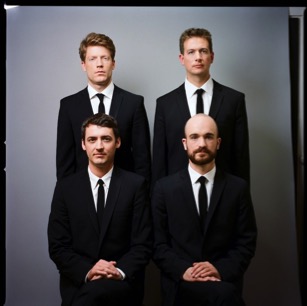Review: Calder Quartet
02/04/16
Calder Quartet concludes Transformer Station residency with intense Beethoven

By MARK SATOLA - Cleveland Plain Dealer
CLEVELAND, Ohio -- The Calder Quartet concluded its two-year, four-concert residency at Transformer Station Thursday with a short but impressive program presenting two works requiring intense concentration on the parts of both performers and listeners.
Anders Hillborg's "Kongsgaard Variations" and Beethoven's String Quartet No. 14 made up the hour-long concert, which was given without intermission.
Hillborg (born 1954) is a prolific Swedish composer of some renown, who has made his living successfully as a freelance composer since 1982. His "Kongsgaard Variations" (2006) are dedicated to John and Maggy Kongsgaard, owners of the Arietta Winery in California's Napa Valley, and Hillborg took as his starting point a snippet from the Arietta movement of Beethoven's last piano sonata, which appears on the label of one of Arietta's signature wines.
The fifteen-minute work, a sort of "variations in search of a theme," is rendered in a free tonality that makes much use of independent counterpoint from each of the instruments, resulting in both unexpected harmonic sweetness and passing clashes of startling dissonance. Eventually, the music moves toward a post-modern apotheosis, wherein the Arietta theme is finally fleshed out in Hillborg's highly individual tonal style, before it breaks apart in a flurry of furious gliding and then dissolves in a cloud of shimmering overtones.
The Calder Quartet's own style, thoughtful and technically assured, was especially well suited to Hillborg's music, which they played with a tonal richness that filled the small gallery at Transformer Station.
The intimacy of the performing space, in which audience members were all quite close to the performers (some as close as five or six feet), was almost too much for the Beethoven quartet. It's one of the composer's most intense essays, both emotionally and in terms of its musical thought, and contains some of Beethoven's most advanced ideas. Its unprecedented formal integration points the way to the structural innovations of Schumann and Liszt.
The Calder Quartet immediately found the dark heart of the opening fugue, a remarkably modern-sounding movement in which dissonances are slow to resolve. The concentration they displayed here was sustained throughout the subsequent movements of its 40-minute span.
In the fourth movement, a set of variations, the Calders were a model of acuity, listening to each other and in effect conversing with each other through Beethoven's advanced writing.
As for the brief Presto that followed, where other quartets have treated it as a light recreation after so much serious dialectic, the Calders applied themselves anew with great vigor, which carried over to the slashing finale, played with such intensity that the small space in Transformer Station could barely contain it.


